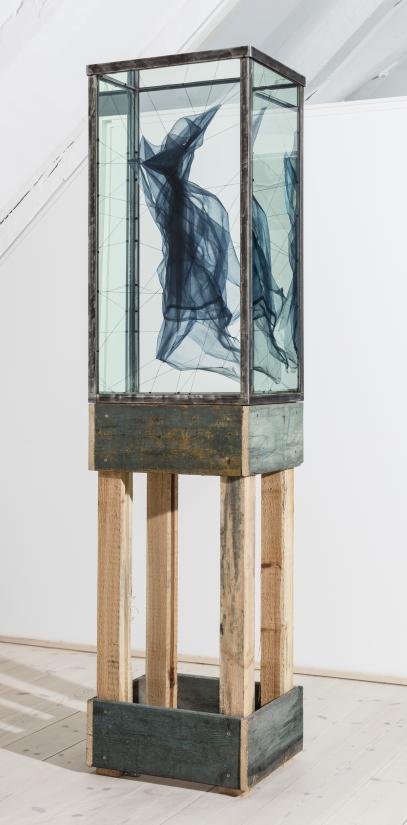Adam Jeppesen’s 2017 series The Pond consists of both photographs and installations. The four pieces from the series that are now included in the collection of Kunstmuseum Brandts are Work no. 080, Work no. 100, Work no. 101 And Object no. 109 (T).
Transformativity
The Pond springs from a fascination with that which perishes to allow something new to emerge. It is thus the transformative aspect of perishability that inspired Jeppesen’s series.
The three pieces Work no. 080, Work no. 100 and Work no. 101 are photographic studies of hands. In Object no. 109 (T), a piece of silk floats in a glass tank suspended in a transparent liquid. Both the hands and the silk fabric evoke a floating illusion. The glass tank distorts our perspective, and the silk fabric seems both alluring and melancholic. Despite the limited sculptural potential of silk, Jeppesen manages to preserve it in mid-fall and give it substance.
The title, The Pond, refers to a natural environment that Jeppesen sees as representative of natural processes that are beyond human control; a wild environment that has its own independent nature and processes and which defies attempts at management or control. In Object no. 109 (T) Jeppesen has suspended the delicate material of silk in a glass tank. In contrast to the untamed processes of decay that unfold in the pond, the silk is captured in a controllable environment in the form of a medicinal oil.
A photographic process without a camera
All four works are treated with cyanotype. Cyanotype as a material is characterized by a particular lightness and dates back to 1842. In a photographic process that does not involve a camera, Jeppesen impregnates a canvas with an emulsion that renders the textile photosensitive. Next, he places a negative on top of the canvas and lets sunlight fixate the image. As the blue colour of the emulsion is fixated by the light, the image appears where the sunlight did not impact the canvas. Finally, the chemical residue is rinsed off the canvas. In Work no. 080, Work no. 100 and Work no. 101 Jeppesen has treated negatives with cyanotype. In Object no. 109 (T) he has treated the silk with cyanotype, which gives it the characteristic blue colour. Jeppesen’s works have an inherent fragility in terms of their imagery as well as physically, as the blueprints are highly sensitive to light.
About Adam Jeppesen
Adam Jeppesen (b. 1978) lives and works in Villa Ruiz, Argentina. He graduated from the Danish school of photography Fatamorgana in 2002. He has exhibited both in Denmark and abroad, including at the National Photo Museum in Copenhagen, C/O Berlin, FOAM in Amsterdam and Scandinavia House in New York City. His works are represented in the collections of the Danish Arts Foundation, Kunstmuseum Brandts and the Denver Art Museum.



